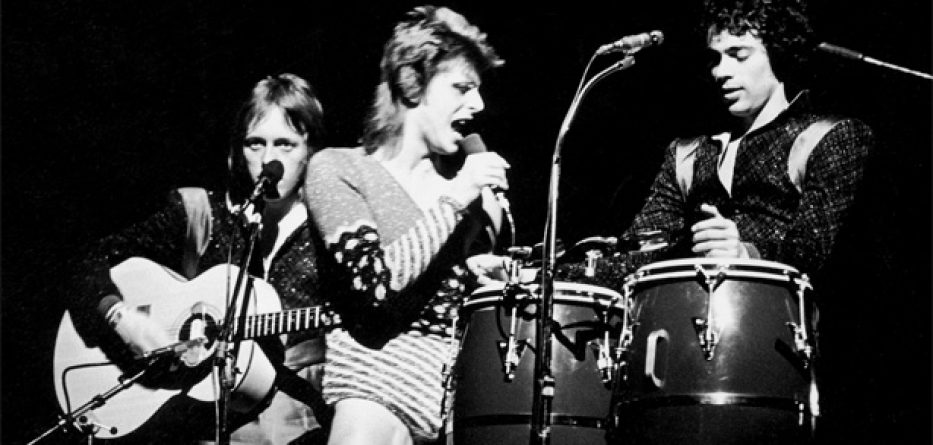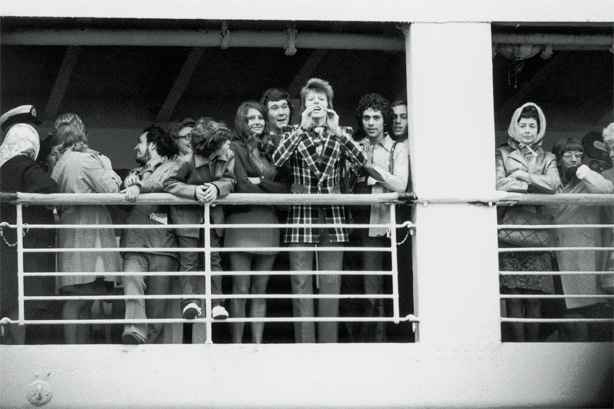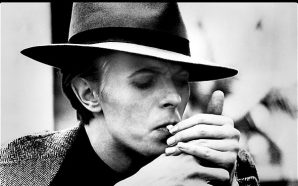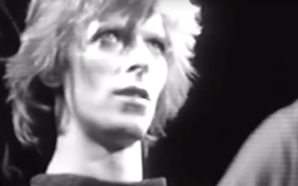This interview with long-time Bowie friend and collaborator Geoff MacCormack originally appeared on www.goldminemag.com.
“Say you’re my friend,” he says, “and I invite you to a party, and the party goes on for three years, and you change costumes, and maybe we go home and say hello to mother — which is important, obviously — and we check with our families and, and we do all that, and we come back to the party and we carry on the theme, or the next theme, or the other theme, or whatever the theme is going to be and that’s kind of what it’s like.”
What MacCormack is talking about is the whirlwind trio of years he spent, circa 1973-1976, touring as part of David Bowie’s band, as a backup singer and a percussionist.
More than just a member of the band, however, MacCormack was an integral part of Bowie’s creative life onstage and off, his constant companion while they were on the road — Bowie had a terrible fear of flying, and thus, only travelled by train, boat or car — and, simply, his best friend. Beyond even that, MacCormack was part and parcel to Bowie’s life when, arguably, he was the single most important musician on the planet.
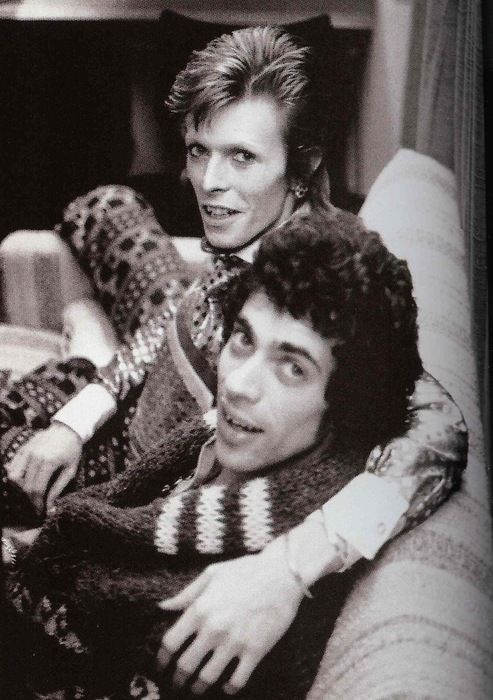
Geoff MacCormack and David Bowie relax backstage
During the three years that MacCormack toured and recorded with Bowie, he was part of five records — from Aladdin Sane to Station to Station — and six different tours. Nor were these just any regular rock and roll tours; they were Bowie at his mid-1970’s creative peak, through America, Japan and England in 1973, and then across North America in 1974 as part of the Diamond Dogs and “Soul” tours, which were — at the time — the most comprehensive rock tours of continent then undertaken.
It all amounted to a mad rush, an entropic barnstorm of great music and great theatre that set the standard not only for rock shows, but for rock and roll music itself. It is a standard that’s still copied today, and which, in many ways, has yet to be lived up to. Bowie’s live shows of the ‘70s are legendary, and MacCormack was not only front and centre for them, he was fundamental to their very happening.
MacCormack details those three wild years in the new book From Station to Station: Travels with Bowie 1973 – 1976 from Genesis Publications. It is a deluxe volume, leather bound and gold trimmed, replete with never-before-seen pictures of Bowie, reproductions of programs and mementos and chock full of inside information that, if anything, makes the ultimate rock and roll god seem, well, just like a regular guy having a good time on the road.
That, of course, has to be taken in context. A good time for Bowie — and MacCormack by association — would be an amazing fantasy for 99.9 percent of us. In MacCormack’s words, as it’s related in “Station To Station,” he’s simply having a nice little go-round with an old friend. Amazingly enough, that’s precisely what it was.
Yes, Bowie was immensely popular, and sought after by every groupie and rock ‘n’ roll wannabee on the planet, but to MacCormack, he was still little David Jones with whom he attended Burnt Ash School in London, and with whom he had been best friends since they were seven years old.
MacCormack was in his mid-20s, working as an ad sales associate on a magazine, when he got a call from Bowie informing him that he was now in Bowie’s band, that they were going to America, and that he was going to accompany Bowie on a trans-Atlantic luxury liner departing immediately.
Again, it’s the ultimate rock fantasy, and MacCormack lived it. Yet, he is remarkably sanguine about it. It was after all, just a call from an old buddy.
“Let’s reverse this,” he says. “Say your best pal does the same thing. Does that really distance him from you as being your best pal? Does that change your identity with him and what he’s doing? If the answer is no, that’s pretty well where I was with David.”
That’s just how MacCormack comes off in the book and in person. He’s grateful for the experience, reflective of the importance of what he was a part of, and well aware of the musical magnitude of what he was doing. Still, though, he’s friendly, open and gregarious.
MacCormack knows he played an important role in rock history, but he’s not awestruck by it. After all, he wasn’t there simply based on friendship; to be on stage with Bowie, especially during such an important tour, he had to be able to keep up.
It’s well known that Bowie partied hard, but he worked equally as hard. To play to packed arenas and hold his own onstage with a colossal talent like Bowie, he had to have a fair amount of his own talent in the bank.
What MacCormack relates is that, yes, he was lucky to have a friend like Bowie, but Bowie also recognized that talent in his old friend, and it was Bowie’s abilities that set MacCormack’s free.
“The stuff that I got from those early years were helpful to me to help me believe that I could go out and do those many things,” he says. “The thing that Bowie makes you believe is that you can go out and do those things, so that’s what I got from him. It’s one of those things that you’ve got a friend who’s got these amazing talents and you kind of reflect off that.”
While the narrative that MacCormack spins in the book is not the most polished, it is friendly and accessible, and it’s truly the pictures that tell the story. These are photographs that were taken by MacCormack — in most cases — in moments of repose while the two were traveling, or relaxing on a boat or in a hotel room or, frequently, on a train, such as their pair’s epic journey on the Trans-Siberian Railway.
What’s even more disarming about the pictures, and the story they tell, is that MacCormack took them in the spirit of the moment. He never entered a situation intending to document rock and roll history, a la Annie Liebowitz and The Rolling Stones “Rock and Roll Babylon.”

David Bowie, Geoff MacCormack and Ronnie Wood
“The thing is, I never intended — as you’ve seen the book — in capturing this or capturing that,” he says. “If you can imagine going on holiday with somebody, or some people, or a crowd of people, and taking snapshots, that’s basically what the book’s about: taking snapshots of being a part of something but not being someone who actually wants to document something. It’s an accidental event.”
Some happy accident indeed, and some crowd of people — one of the greatest names in the history of music, with one of the great touring bands in the history of music on a half dozen of the greatest rock and roll tours in the history of music.
MacCormack and Bowie are still good friends, as evidenced by the familiar and amiably sarcastic foreward that Bowie penned for the book. He speaks of Bowie, and all that happened between them in that important three-year period, warmly and basks in Bowie’s approval of the tome.
That, ultimately, is what emerges from “Station To Station.” It is a tale of two friends on an amazing journey as young men, such as any two friends might take at a given time in their youth.
It just so happens that one of the friends is one of rock and roll’s all-time greatest talents, and the journey happened to be one that altered the course of modern music and remains a touchstone to this day.
Not bad for a couple of boyhood chums who sang together in the choir in primary school.

